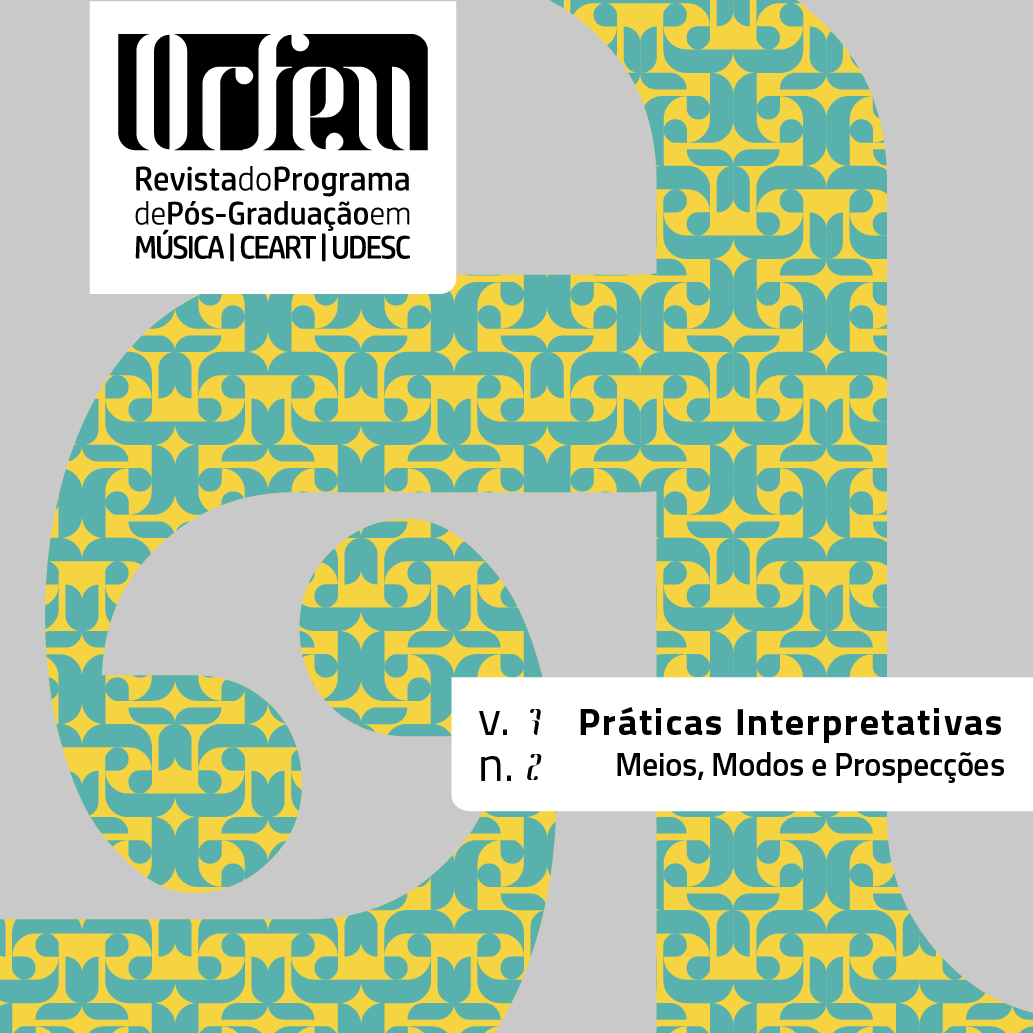Musicking performances as performances of existence
DOI:
https://doi.org/10.5965/2525530407022022e0103Keywords:
Performances, Musical Performances, Musicking PerformancesAbstract
This text presents the idea of Musicking performances as performances of existence. This idea was developed based on performance conceptions from an artistic and anthropological point of view, drawing connections with musical performances and educational ideas. It was structured through field research, which included online interviews with twelve cello teachers from eight musical spaces for beginning students’ cello teaching and learning in Brazil. This study uses ethnography, autoethnography, and cartography, and considers performances with musical practices as pedagogical processes of representation of ways of existing that extend to everyday life. Ideas are approached as processes in becoming, typical of musicking practices in the action of breaking themselves up and building again under new configurations.
Downloads
References
BOAL, Augusto. A Estética do Oprimido. Rio de Janeiro: Editora Garamond Ltda, 2009.
CARLSON, Marvin. Performance: uma introdução crítica. Belo Horizonte: Editora UFMG, 2009.
CLARK, Lygia. A propósito da magia do objeto. In: CLARK, Lygia. Textos de Lygia Clark, Ferreira Gullar e Mário Pedrosa. Rio de Janeiro: FUNARTE, 1980. p. 25-26.
CONE, Edward. Musical Form and Musical Performance. New York: W.W. Norton & Campany, 1968.
FREIRE, Paulo. Pedagogia do Oprimido. 69. ed. Rio de Janeiro/São Paulo: Terra e Paz, 2019.
FONTERRADA, Marisa Trench de Oliveira. De tramas e fios: Um ensaio sobre música e educação. 2 ed. São Paulo: Editora UNESP; Rio de Janeiro: Funarte, 2008.
GOHN, Daniel Marcondes. Aulas on-line de instrumentos musicais: novo paradigma em tempos de pandemia. Revista da Tulha, Ribeirão Preto, v. 6, n. 2, p. 152-171, 2020.
ICLE, Gilberto. Da performance na educação: perspectivas para a pesquisa e a prática. In: PEREIRA, Marcelo de Andrade (Org). Performance e Educação: (des)territorializações pedagógicas. Santa Maria: Editora UFSM, 2013, p. 9-22.
PEREIRA, Marcelo de Andrade. Performance docente: sentidos e implicações pedagógicas. In: Performance e Educação: (des)territorializações pedagógicas. Santa Maria: Editora UFSM, 2013. p. 23-36.
PINEAU, Elyse. Nos Cruzamentos entre a Performance e a Pedagogia: uma revisão prospectiva. Revista Educação e Realidade, Porto Alegre, v. 35, n. 2, p. 89-113, 2010.
RESTREPO, Eduardo. Etnografía: alcances, ténicas y éticas. Bogotá: Envión Editores, 2016.
ROLNIK, Suely. Cartografia Sentimental: Transformações Contemporâneas do Desejo. 2 ed. Porto Alegre: Editora Meridional: Editora da UFRGS, 2016.
ROTHSTEIN, William. A análise e o ato da performance. In: Chueke, Zélia (Org). Leitura, Escuta e Interpretação. Curitiba: Ed. UFPR, 2019. p. 81-122.
SANTOS, Silvio Matheus Alves. O método da autoetnografia na pesquisa sociológica: atores, perspectivas e desafios. PLURAL, Revista do Programa de Pós‑Graduação em Sociologia da USP, São Paulo, v. 24, n. 1, p. 214-241, 2017.
SCHECHNER, Richard. 2006. O que é performance? In: SCHECHNER, Richard. Performance studies: an introduccion. 2 ed. New York & London: Routledge, 2006.
SMALL, Christopher. El Musicar: Un ritual en el Espacio Social. Revista Transcultural de Música, n. 4, 1999. p. 1-16.
TARASTI, Eero. A música como arte narrativa. In: Chueke, Zélia (Org). Leitura, Escuta e Interpretação. Curitiba: Ed. UFPR, 2019. p. 49-80.
YING, Liu Man. O ensino coletivo direcionado ao violino. 2007. 227 f. Dissertação (Mestrado em Artes - Musicologia) – Escola de Comunicações e Artes, Universidade de São Paulo, São Paulo, 2007.
Published
How to Cite
Issue
Section
License
Copyright (c) 2022 Marta Brietzke, Mário Oliveira, Fabio Presgrave

This work is licensed under a Creative Commons Attribution 4.0 International License.
Authors who submit their manuscripts to be published in this journal agree to the following terms:
1. Authors retain the copyright and grant to the journal the right of first publication, whilst simultaneously permitting their work to be licensed under the Creative Commons License Attribution, which allows the sharing of work with recognition of the authorship and initial publication in this journal.
2. Contributions in this journal are open access; this means they are based in free use, and non-commercial applications.






